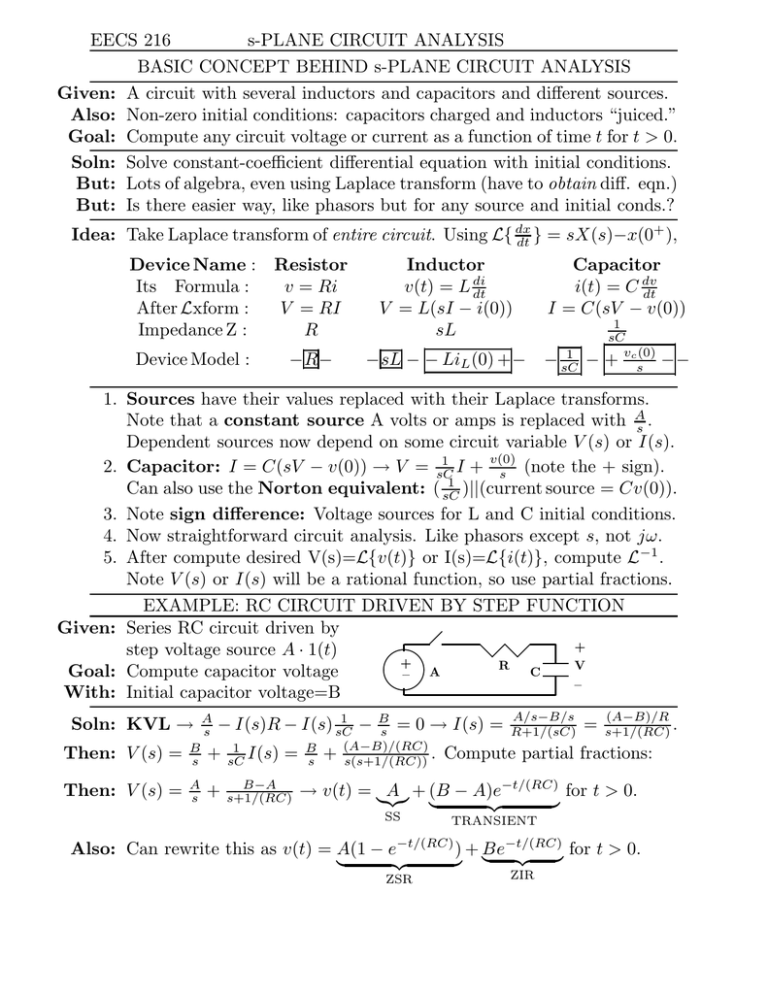EECS 216 s-PLANE CIRCUIT ANALYSIS BASIC CONCEPT
advertisement

EECS 216
s-PLANE CIRCUIT ANALYSIS
BASIC CONCEPT BEHIND s-PLANE CIRCUIT ANALYSIS
Given: A circuit with several inductors and capacitors and different sources.
Also: Non-zero initial conditions: capacitors charged and inductors “juiced.”
Goal: Compute any circuit voltage or current as a function of time t for t > 0.
Soln: Solve constant-coefficient differential equation with initial conditions.
But: Lots of algebra, even using Laplace transform (have to obtain diff. eqn.)
But: Is there easier way, like phasors but for any source and initial conds.?
+
Idea: Take Laplace transform of entire circuit. Using L{ dx
dt } = sX(s)−x(0 ),
Device Name :
Its Formula :
After Lxform :
Impedance Z :
Resistor
v = Ri
V = RI
R
Device Model :
−R−
Inductor
v(t) = L di
dt
V = L(sI − i(0))
sL
Capacitor
i(t) = C dv
dt
I = C(sV − v(0))
1
−sL − − LiL (0) +− − sC
−
1
sC
+ vcs(0)
−−
1. Sources have their values replaced with their Laplace transforms.
Note that a constant source A volts or amps is replaced with As .
Dependent sources now depend on some circuit variable V (s) or I(s).
1
I + v(0)
(note the + sign).
2. Capacitor: I = C(sV − v(0)) → V = sC
s
1
Can also use the Norton equivalent: ( sC )||(current source = Cv(0)).
3. Note sign difference: Voltage sources for L and C initial conditions.
4. Now straightforward circuit analysis. Like phasors except s, not jω.
5. After compute desired V(s)=L{v(t)} or I(s)=L{i(t)}, compute L−1 .
Note V (s) or I(s) will be a rational function, so use partial fractions.
EXAMPLE: RC CIRCUIT DRIVEN BY STEP FUNCTION
Given: Series RC circuit driven by
✤✜
+
step voltage source A · 1(t)
❅ ❅
+
R
V
A
C
Goal: Compute capacitor voltage
–
–
✣✢
With: Initial capacitor voltage=B
Soln: KVL →
A
s
A/s−B/s
(A−B)/R
B
s = 0 → I(s) = R+1/(sC) = s+1/(RC) .
(A−B)/(RC)
s(s+1/(RC)) . Compute partial fractions:
1
− I(s)R − I(s) sC
−
Then: V (s) =
B
s
+
1
sC I(s)
Then: V (s) =
A
s
+
B−A
s+1/(RC)
=
B
s
+
→ v(t) = A + (B − A)e−t/(RC) for t > 0.
SS
TRANSIENT
Also: Can rewrite this as v(t) = A(1 − e−t/(RC) ) + Be−t/(RC)
for t > 0.
ZSR
ZIR
EECS 216
Given:
Initially:
Then:
Goal:
KVL:
REDO PREVIOUS 2nd -ORDER CIRCUIT EXAMPLE:
Circuit shown at right:
1H ✲ +
✤✜
i(0) = 0 and v(0) = −1
I
❅ ❅
+
4Ω
1
2cos(3t)
F
V
Throw switch at t = 0.
–
3
✣✢
–
Compute i(t) for t > 0
2s
s2 +9
Solve: I =
L−1 :
Then:
1.
2.
3.
Given:
Initially:
Then:
Goal:
s-PLANE CIRCUIT ANALYSIS
− 4I − s1I + 0 −
3s2 +9
(s2 +9)(s2 +4s+3)
=
1
s 13
I−
0.223ej27
s+j3
−1
s
1
3
= 0 → I = [ s22s
+9 + s ]/[4 + s + s ].
o
+
0.223e−j27
s−j3
o
o
+
0.6
s+1
+
−1
s+3
PARTIAL
FRACTION
o
i(t) = 0.223e−j3t+j27 + 0.223ej3t−j27 + 0.6e−t − e−3t for t > 0
Simplifies to: i(t) = 0.447 cos(3t − 27o ) + 0.6e−t − e−3t for t > 0.
This agrees with previous handout result using differential equations.
Note characteristic equation appears in denominator of I(s) expression.
Partial fraction shows where transient and steady-state responses arise.
The circuit shown at right:
Switch closed for long time.
Switch is opened at t = 0.
Compute vC (t) for t > 0.
✤✜
+
10V
–
✣✢
t = 0− : C → open and L → short → iL (0− ) =
10
50
❅ ❅
50Ω
10Ω
0.02F
✆
5H
✆
✆
= 0.2 and vC (0− ) = 0.
t = 0+ : We don’t need rest of the messy computation from previous handout!
Now: With the swich open, this is now just a voltage divider for VC (s):
VC (s) =
1/(0.02s)
(−5(0.2))
1/(0.02s)+10+5s
=
−10
s2 +2s+10
=
(−3.33)(3)
(s+1)2 +(3)2
so that:
L−1 : vc (t) = −3.33e−t sin(3t) for t > 0. Agrees with the previous handout.
1. We don’t need to go through previous mess of finding dvdtC (0+ ) (ugh).
2. We can compute inverse Laplace transform without partial fractions.
3. Note characteristic equation appears in denominator of I(s) expression.
Given:
Initial:
t=0:
Goal:
Series RLC circuit (resistor+inductor+capacitor connected together).
Capacitor is charged up to v(0) and inductor is “juiced up” to i(0).
Close or throw the switch at t = 0. Recall i(t) and v(t) don’t jump.
Compute current through inductor (and everything else) i(t) for t > 0.
KVL: LiL (0) − sLI − RI −
Soln: i(t) = L−1 of I(s) =
1
I
sC
−
vc (0)
s
si(0)−v(0)/L
1 .
s2 + R
L s+ LC
= 0 → I(s) =
Li(0)−v(0)/s
. Easy!
sL+R+1/(sC) 1
Note the characteristic equation.


